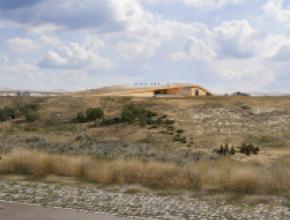The Mars Dune Alpha is a speculative 1,700-square-foot 3D-printed habitat that will simulate living on Mars.
Designed by Bjarke Ingels' BIG architecture and printed by Austin-based ICON construction, the structure will be built at NASA's Johnson Space Center in Houston.

Four individuals will live in the structure for a year. NASA is seeking volunteers - who won't be astronauts, but members of the public - to live there. The team of four will carry out tasks including simulated spacewalks, scientific research, and will use virtual reality - all to simulate how life will be on the Red Planet.

NASA will use the research to inform future missions to Mars.
The habitat will feature four private quarters at one end, with workstations, medical stations, and food-growing areas at the other end. A shared living space will be in between.

|
Varying ceiling heights vertically segmented by an arching shell structure accentuate the unique experience of each area to avoid spatial monotony and crewmember fatigue. A mix of fixed and movable furniture will allow crew members to reorganize the habitat according to their daily needs, as will the customizable lighting, temperature, and sound control – helping regulate the daily routine, circadian rhythm, and overall well being of the crew.
 |
"This is the highest-fidelity simulated habitat ever constructed by humans," said ICON CEO Jason Ballard. "Mars Dune Alpha is intended to serve a very specific purpose — to prepare humans to live on another planet. We wanted to develop the most faithful analog possible to aid in humanity’s dream to expand into the stars. 3D printing the habitat has further illustrated to us that construction-scale 3D printing is an essential part of humanity’s toolkit on earth and to go to the moon and mars to stay."
Applications are being accepted now until September 17. The individuals will need to be U.S. citizens, non-smokers, aged 30-55, have a Masters degree in a STEM field, and be proficient in English. They will also have to pass psych testing, medical evaluations, and physical fitness exams.
If you're interested, the application can be found here.
NASA hopes to begin the year-long mission in the fall of 2022.







Have something to say? Share your thoughts with us in the comments below.